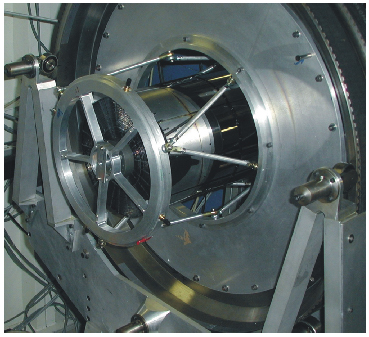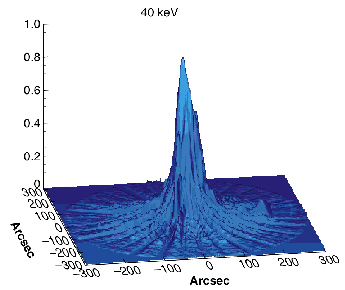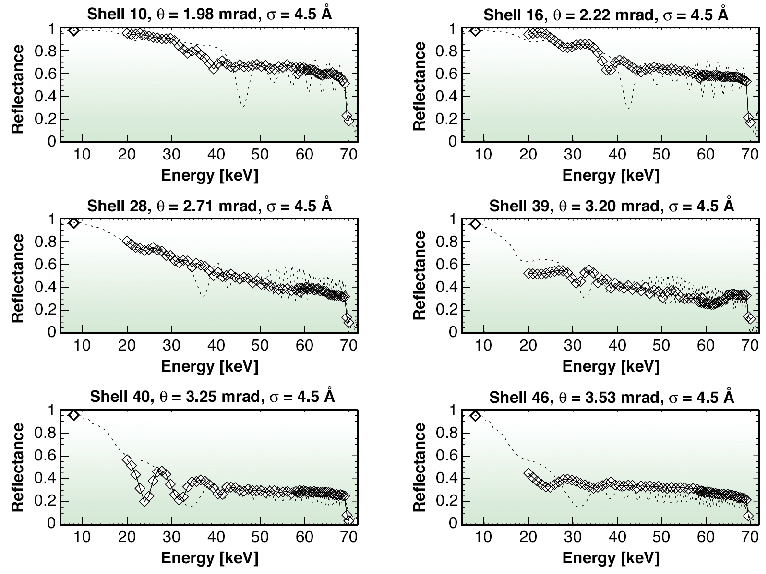- Home
- Users & Science
- Scientific Documentation
- ESRF Highlights
- ESRF Highlights 2004
- X-ray Imaging
- Calibration of a Hard X-ray Telescope
Calibration of a Hard X-ray Telescope
Focusing optics for the hard X-ray band above 10 keV are now poised to open a new window on the high-energy universe. Hard X-ray observations will provide a vehicle for discovering collapsed stars and black holes on all scales, for testing theories of where the elements are born, and for exploring the most extreme environments in the universe. We have developed thermally-formed glass substrates, depth graded W/Si multi-layer coatings for enhanced hard X-ray reflectivity and a unique mounting technique to build high performance, lightweight telescopes with the large effective area necessary to bring high-energy astrophysics into this new era. The large collecting area is achieved by tightly nesting shells of grazing-incidence mirrors in a conical approximation to a Wolter I geometry. Each shell is made of five quintant segments thermally formed into the appropriate conical shape. The raw glass material is flat panel display glass of thickness 0.3 mm (Schott glass D263 and AF45). Each glass segment is coated with optimised depth graded W/Si multilayer coatings capable of reflecting in the energy band up to the W-K absorption edge of 69.5 keV [1]. The novel mounting technique involves constraining the mirrors to successive layers of precisely machined graphite spacers [2]. Our approach is being demonstrated through the High Energy Focusing Telescope (HEFT) balloon program which is a collaboration between California Institute of Technology, Columbia University, Lawrence Livermore National Laboratory and the Danish Space Research Institute (DSRI). We have completed three telescope modules. Each of these contains 72 nested shells totalling several thousand individual mirror segments.
 |
Fig. 152: The hard X-ray telescope in the rotation mechanism. |
The hard X-ray calibration of the first flight telescope was performed at beamline BM05. We used a double bounce Si(111) monochromator with higher order suppression capable of operating in the energy range up to 70 keV. The beam was collimated to 1 arcsec. The optic was mounted in a ring, which allowed precise rotation around the optical axis. This in combination with a simultaneous translation of the optic and the detector allowed the illumination of the entire telescope aperture and thus generating a composite image. A CCD was used as the imaging detector. Figure 152 shows a photograph of the optic as it sits in the rotation mechanism.
 |
Fig. 153: On-axis image measured at 40 keV. The HPD is 1.3 arcmin. |
The purpose of the measurements was to measure the imaging performance specifically the Half Power Diameter (HPD) which is the angular range within which half of the photons are focused for an on-axis source and the absolute throughput versus energy. Imaging measurements was performed at four selected hard X-ray energies, 18, 40, 50 and 68 keV and we measured the absolute throughput of selected shells at their specific on-axis graze angle versus energy from 8 to 70 keV. We found that the imaging performance varied slightly with energy with an average HPD of 1.3 arcmin. This variation was, however, not due to any additional scatter at high energies but rather resulted from the different weighting of the imaging performance from the mirror shells. The high energy throughput is mainly facilitated by the small radius mirrors and lower energy throughput facilitated from outer radius shells and the slight variation of the imaging performance with energy was completely explained by the difference in mirror shell figure versus radius. Figure 153 shows the composite image at 40 keV. The measurements of the absolute throughput from selected shells quantitatively verified our model for the multilayer reflectivity and obscuration effects in the entire energy range from 8 to 70 keV. Figure 154 shows reflectivity data versus energy for selected shells in the telescope along with model calculations including known obscuration effects and theoretical reflectivities.
 |
|
Fig. 154: Measured reflectivity versus energy from selected shells. The dotted line is the theoretical reflectivity. The measured data show a smoother variation as expected from mirrors with figure error on order 1 arcmin. In all cases an interfacial roughness of 4.5 Å in the multilayer stack is consistent with the data. |
References
[1] C.P. Jensen, C.M.H. Chen, F.E. Christensen, K.K. Madsen, E. Ziegler; SPIE, 4851, 724-733 (2002).
[2] J.E. Koglin, F.E. Christensen, J. Chonko, W.W. Craig, T.R. Decker, F.A. Harrison, C.P. Jensen, M. Sileo, D.L. Windt, H. Yu; SPIE, 4851, 607-618 (2002).
Principal Publication and Authors
J.E. Koglin (b), C.M.H. Chen (c), J. Chonko (b), F.E. Christensen (a), W.W. Craig (d), T.R. Decker (d), K.S. Gunderson (d), C.J. Hailey (b), F.A. Harrison (c), C.P. Jensen (a), K.K. Madsen (a), M. Stern (b), D.L. Windt (b), H. Yu (b), E. Ziegler (e); SPIE, 5168, 100-111 (2003).
(a) Danish Space Research Institute (Denmark)
(b) Columbia University, New York (USA)
(c) California Institute of Technology (USA)
(d) Lawrence Livermore National Laboratory (USA)
(e) ESRF



